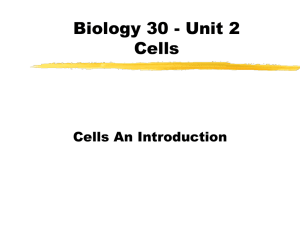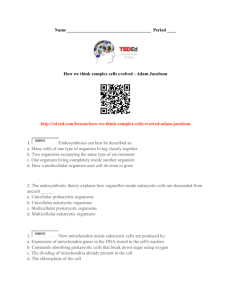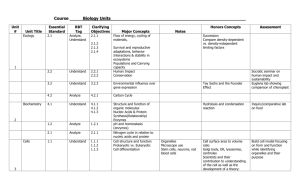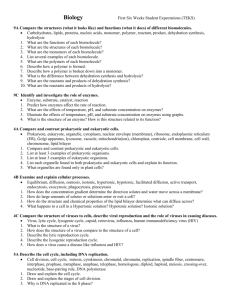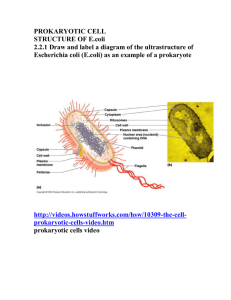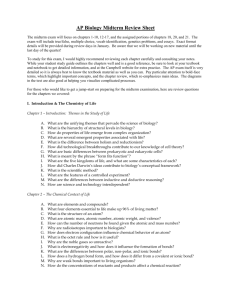Unit 1: CELLS: Structure and Function Week #1 7
advertisement
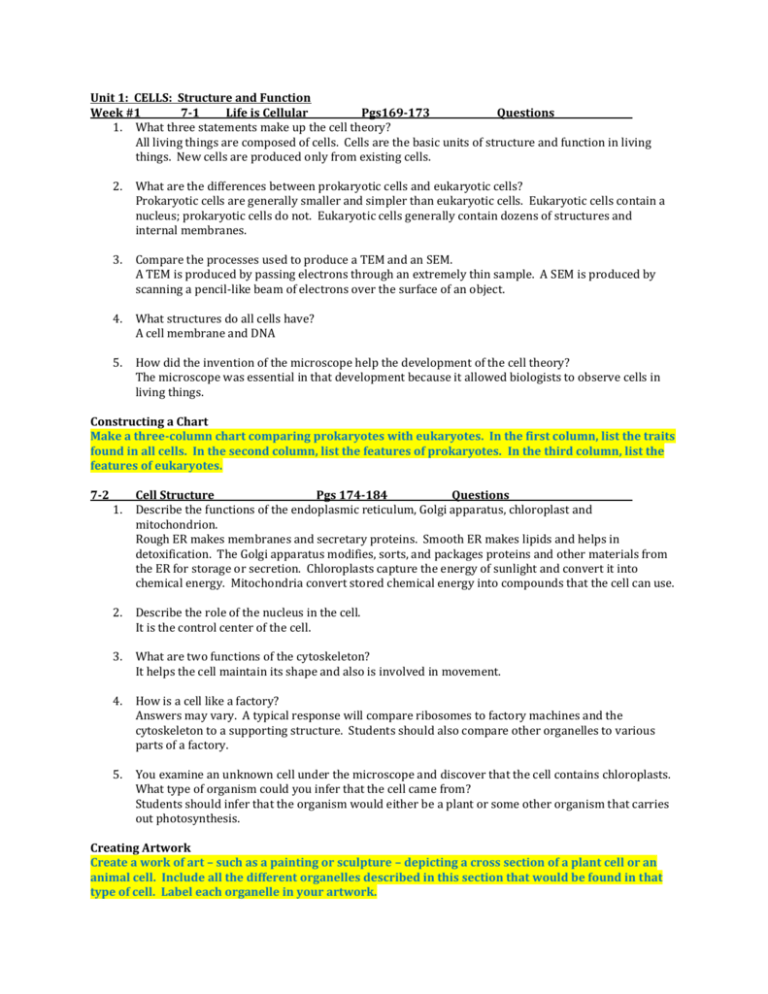
Unit 1: CELLS: Structure and Function Week #1 7-1 Life is Cellular Pgs169-173 Questions 1. What three statements make up the cell theory? All living things are composed of cells. Cells are the basic units of structure and function in living things. New cells are produced only from existing cells. 2. What are the differences between prokaryotic cells and eukaryotic cells? Prokaryotic cells are generally smaller and simpler than eukaryotic cells. Eukaryotic cells contain a nucleus; prokaryotic cells do not. Eukaryotic cells generally contain dozens of structures and internal membranes. 3. Compare the processes used to produce a TEM and an SEM. A TEM is produced by passing electrons through an extremely thin sample. A SEM is produced by scanning a pencil-like beam of electrons over the surface of an object. 4. What structures do all cells have? A cell membrane and DNA 5. How did the invention of the microscope help the development of the cell theory? The microscope was essential in that development because it allowed biologists to observe cells in living things. Constructing a Chart Make a three-column chart comparing prokaryotes with eukaryotes. In the first column, list the traits found in all cells. In the second column, list the features of prokaryotes. In the third column, list the features of eukaryotes. 7-2 1. Cell Structure Pgs 174-184 Questions Describe the functions of the endoplasmic reticulum, Golgi apparatus, chloroplast and mitochondrion. Rough ER makes membranes and secretary proteins. Smooth ER makes lipids and helps in detoxification. The Golgi apparatus modifies, sorts, and packages proteins and other materials from the ER for storage or secretion. Chloroplasts capture the energy of sunlight and convert it into chemical energy. Mitochondria convert stored chemical energy into compounds that the cell can use. 2. Describe the role of the nucleus in the cell. It is the control center of the cell. 3. What are two functions of the cytoskeleton? It helps the cell maintain its shape and also is involved in movement. 4. How is a cell like a factory? Answers may vary. A typical response will compare ribosomes to factory machines and the cytoskeleton to a supporting structure. Students should also compare other organelles to various parts of a factory. 5. You examine an unknown cell under the microscope and discover that the cell contains chloroplasts. What type of organism could you infer that the cell came from? Students should infer that the organism would either be a plant or some other organism that carries out photosynthesis. Creating Artwork Create a work of art – such as a painting or sculpture – depicting a cross section of a plant cell or an animal cell. Include all the different organelles described in this section that would be found in that type of cell. Label each organelle in your artwork. 7-3 1. Transport Pgs 183-189 Questions Describe the functions of the cell membrane and cell wall. The cell membrane regulates what enters and leaves the cell and also provides protection and support. The cell wall provides support and protection for the cell. 2. What happens during diffusion? Particles tend to move from an area where they are more concentrated to an area where they are less concentrated. 3. Describe how water moves during osmosis. Osmosis is the diffusion of water through a selectively permeable membrane. 4. What is the basic structure of a cell membrane? The basic structure is a double-layered sheet called a lipid bilayer, in which proteins are embedded. 5. What is the difference between phagocytosis and pinocytosis? In phagocytosis, extensions of cytoplasm surround a particle and package it within a food vacuole. In pinocytosis, tiny pockets form along the cell membrane, fill with liquid and pinch off to form vacuoles within the cell. 6. What is the main way that active transport differs from diffusion? Active transport requires the input of energy, but diffusion does not require additional energy. Homeostasis What is the relationship between active transport and homeostasis? Give one example of active transport in an organism, and explain how the organism uses energy to maintain homeostasis. 7-4 1. Cell Diversity Pgs 190-193 Questions In what kinds of organisms is cell specialization a characteristic? Multicellular organisms have cell specialization. 2. List the levels of biological organization in multicellular organisms from most simple to most complex. Individual cells, tissues, organs and organ systems 3. How are unicellular organisms similar to multicellular organisms? Both unicellular and multicellular organisms grow, respond to the environment, transform energy and reproduce. 4. Using what you know about the ways muscle moves, predict which organelles would be most common in muscle cells. Muscle cells have a large number of mitochondria, because mitochondria release energy from stored food molecules and muscle cells need great amounts of energy to do the tasks they do. Using Analogies Use an organized area in your life – such as school, sports, or extracurricular activities – to construct an analogy to explain how the levels of organization in that chosen area can be compared with those of living organism. Week#2 10-1 Limits to Growth Pgs 241-243 Questions 1. Give two reasons why cells divide. The larger a cell becomes, the more demands the cell places on its DNA and the more trouble the cell has moving enough nutrients and wastes across the cell membrane. 2. How is a cell’s DNA like the books in a library? The information that controls a cell’s function is stored in DNA, just as information needed by the public is stored in the books of a library. A cell’s DNA, then, is a “genetic” library. 3. As a cell increases in size, which increases more rapidly, its surface area or its volume? Its volume 4. Calculate the surface area, volume, and ratio of surface area to volume of an imaginary cubic cell measuring 4 cm on each side. The surface area is 96 cm2, the volume is 64 cm3, and the ratio of surface area to volume is 96/64 = 3 : 2. Cellular Basis of Life Select two cell organelles and describe how their functions might be impaired if the cell were to become too large. A review of Chapter 7 may help you with this task. 10-2 Cell Division Pgs 244-249 Questions 1. Name the main events of the cell cycle. A cell grows, prepares for division, and divides to form two daughter cells. 2. Describe what happens during each of the four phases of mitosis. Students should describe what happens during prophase, metaphase, anaphase and telophase, as in Figure 10-5. 3. Describe what happens during interphase. Students should describe what happens during the G1 phase, S phase and G2 phase. 4. What are chromosomes made of? DNA, which carries the cell’s coded genetic information and proteins. 5. How do prokaryotic cells divide? A prokaryotic cell first replicates its genetic information before cell division begins. In most prokaryotes, the rest of the process of cell division is a simple matter of separating the contents of the cell into two parts. 6. How is cytokinesis in plant cells similar to cytokinesis in animal cells? How is it different? Cytokinesis is the division of the cytoplasm in both types of cells. The difference is that in plant cells a cell plate forms midway between the divided nuclei. Creative Writing Suppose you were small enough to hitch a ride on a chromosome located in a plant cell that goes through mitosis and cytokinesis. Describe what you would see happening during each phase of the process. 10-3 1. Regulating the Cell Cycle Pgs 250-252 Questions What chemicals regulate the cell cycle? How do they work? Cyclins regulate the timing of the cell cycle in eukaryotic cells. Cyclin may cause a mitotic spindle to form and trigger cell division. 2. What happens when cells do not respond to the signals that normally regulate their growth? Such cells, called cancer cells, divide uncontrollably and form masses of cells called tumors that can damage the surrounding tissues. 3. How do cells respond to contact with other cells? Normal cells respond by not growing. 4. Why can cancer be considered a disease of the cell cycle? The cell cycle is the series of events that cells go through as they grow and divide, and cancer is a disorder in which some of the body’s cells lose the ability to control growth. 5. Write a hypothesis about what you think would happen if cyclin were injected into a cell that was in mitosis. A typical hypothesis might suggest that cyclin would have no effect because the cell was already in mitosis. Problem Solving Imagine that you are developing a drug that will inhibit the growth of cancer cells. Use your knowledge of the cell cycle to describe how the drug would target and prevent the multiplication of cancer cells. Use the Internet to compare your anticancer drug with those currently in use. 40-4 1. Cancer Pgs 1052-1054 Questions Describe the environmental factors that affect your health. Students should describe air and water quality, poisonous wastes in landfills and exposure to solar radiation. 2. Name three things you can do to maintain your health. Any three of the following: eating a healthful diet, getting enough exercise and rest, abstaining from harmful activities, and having regular checkups. 3. List some of the causes of cancer. Cancers are caused by defects in the genes that regulate cell growth and division. These defects may be inherited or caused by viruses, or they may result from mutations in DNA produced by radiation or chemicals. 4. Why are regular medical checkups and self-examinations important? Regular medical checkups and self-examinations are important for detecting problems early so that there is a better chance of treating them successfully. 5. Should cancer be considered an infectious disease? Explain your answer. Most cases of cancer are not infectious. However, cancer-causing viruses can be passed from person to person. Cellular Basis of Life Recall the cell cycle from Section 10-2. In which phase do you think cells would be most vulnerable to damage from radiation? Explain your choice. What characteristic of cancer cells might make them especially vulnerable?

